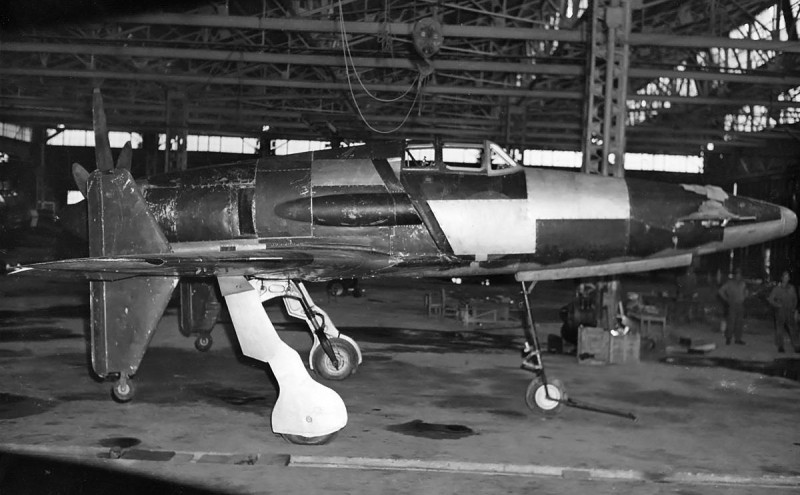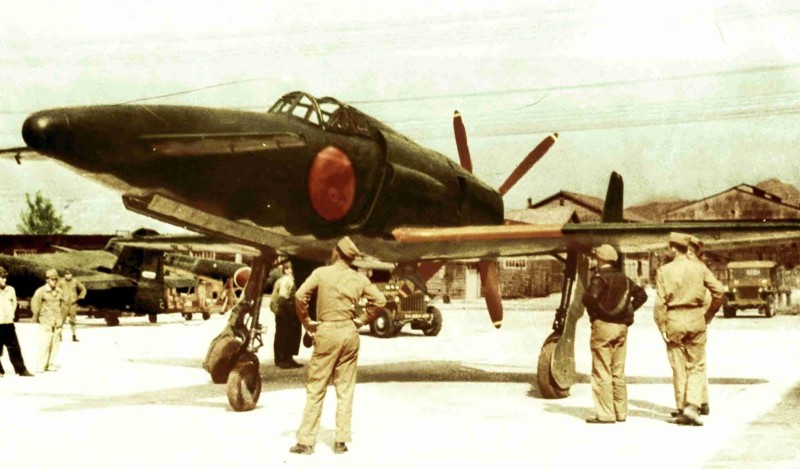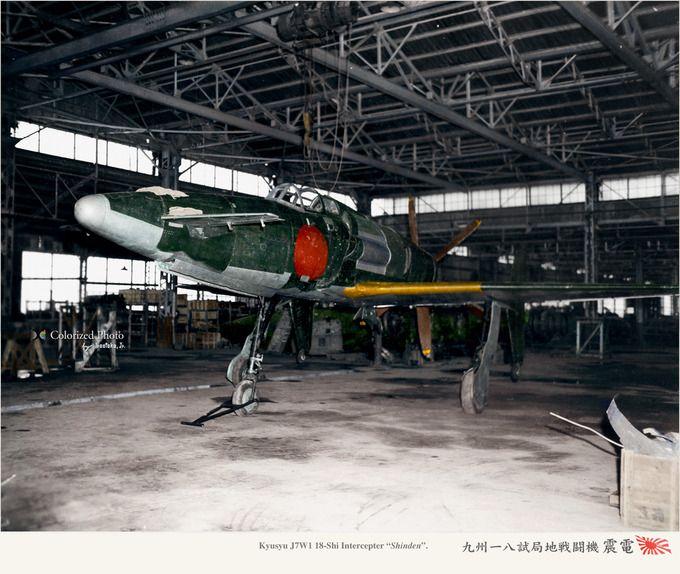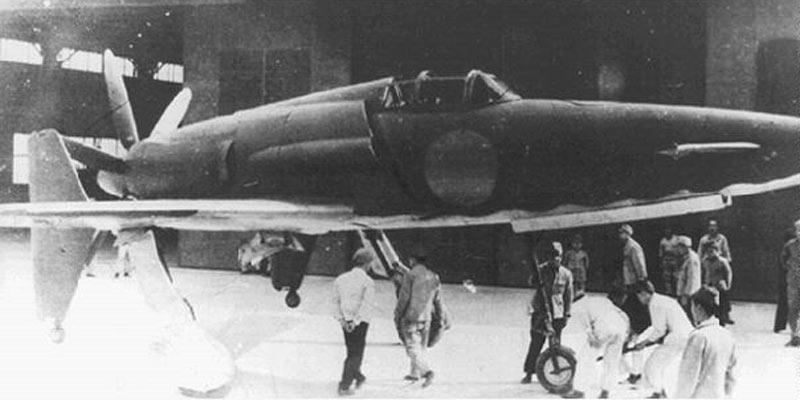Zoukei Mura Kyushu J7W1, 1/48. 'Magnificent Lightning'.
-

1. The Shiden following it's replacement panels being added, prior to painting. The canopy has no glass. The underside seems to be metallic rather than painted.
What's your favourite aircraft? For me, unsurpsingly, its the Corsair. But what aircraft absolutely fascinates you? For me it's the J7W1. Whilst I don't particularly subscribe to the Luft '46 and other similar interests due to them often being
too over the top, I must admit the J7W1 is one aeroplane that fits into this area that I am very fond of.
-

1. Colourised rendition of the Shiden
I've long been a fan of this aircraft and the 'What If?' questions that surround it. It's an aircraft that's design seems alien compared to other aircraft at the time (excluding that XP-55, which is like the J7W got hit with an ugly stick), a massive machine with a nose mounted canard and a big engine in a pusher configuration. Designed to be able to climb and intercept the best of the U.S bombers of the war, the B-29, one can't help but wonder how this aircraft that wouldn't be out of place in a sci-fi movie would have performed. Luckily for U.S airmen, and Japanese aviators that would have to flown her, the J7W1 Shinden never saw service.
-

1. Another colourised photo, highlighting the replacement panels.
As such, the history of the aircraft is brief and much has been either lost due to the Japanese tendancy to destroy documents after the ceasefire, or documents remain hidden and untranslated, this helps give the aircraft its mysterious aura. Only two prototypes were built (with one awaiting an engine), with a third in it's beginning steps of construction, with the type completing it's first flight on August 3, 1945, as well as two further short flights on August 6 and 9, for a total of around 45 minutes flight time. Naturally these last two dates were overshadowed by more important matters, being the same days the atomic bombs were dropped.
-

1. In this photo we really just see how tall the Shiden was.
After the war the one completed prototype survived and was seized by the US Military, the second and third prototypes were dismantled and loaded onto trucks, placed into a pit, burnt with gasoline and then buried. The only survivor is currently displayed as just the forward fuselage at the National Air and Space Museum in America.
Despite its fate today, some good yet rare photos exist of the Shinden. Many were from immediately after the war in which the damaged aircraft, possibly caused by a Typhoon, was repaired by Japanese personnel under US orders before being repainted and shipped to America. To be honest its easier to find photos of the Shinden than the F4U-1C. There's even a video of the aircraft being tested which is quite a rare find. Today the Shinden lives on with it's design appearing, or heavily inspiring, in various games, comics and movies.
The Kit
The kit for this project is Zoukei Mura's brilliant J7W1 1/48. For a Shinden, your choice is either the old Hasegawa kit complete with raised panel lines everywhere, or the exceedingly rare Zoukei Mura offer.
To nail on how rare this kit is, I can't find any retailers from the UK, Europe or Japan (at least the websites with English) that sell this kit. I took to looking at eBay, and sadly lost the bid of one at an absolute steal of a price. I've seen them go second hand for £180 which is ridiculous, luckily I didn't pay not nearly that much for mine but still this is the most expensive kit I've purchased.
From what I've read, Zoukei-Mura's goal with their 1/32 line was to provide a high detail kit with plenty of internal details in order to allow the modeller to learn what goes into the real aircraft in the unseen areas. You'll note that in their other kits they all have guns, fuel tanks, radios, and other such details often left out. The 1/48 Shinden is a shrunken down version of their previous 1/32 release and still offers a very impressive amount of internal details for a modeler to decide whether to show or not.
After having it the stash for a while, I also treated myself the the Concept Note book that came out for this model, it contains a lot of high quality photographs and models to take inspiration from. Was it worth it? Probably not, it is interesting though and I'm a s****r (su ck er is censored?) for a model and an accompanying book.
Looking through the instructions we can see just what we are getting into with this build, a highly detailed engine occupies the first 4 steps consisting of 13 parts (with 8 more parts to be added later on). This already looks like the best plastic engine I've seen in a kit. After this, a detailed yet simple construction rendition of the cockpit is put onto an framework with wing spars to provide strength to the model, before fuel tanks and a fully detailed gunbay are placed. After this the engine is placed, some work is done to the wheel bays, and you should be left with a very naked Shinden. The final steps of the model include adding the very long landing gear, but also placing all the exterior panels onto the aircraft like a 'shell'. Before doing this, one has the choice to simply cut open any panels they'd like off of this 'shell' to reveal the details hidden inside. With so much internal detail, some panels will definitely be removed from this build.
The kit comes with 5 sprues in a cream/white colour, and 1 clear sprue, and a small sheet of decals depicting the prototype Shinden.
On sprue A we see the forward sub-assemblies such as the 30mm cannons, and the detailed cockpit, as well as the Shinden's skeleton that all future parts will in someway attach to.
On sprue B we see the aft sub-assemblies, notably of course the engine, propeller, intakes and various fuel/oil tanks.
On sprue C we get a glimpse of the outer 'shell' of this model, all the external panels for the fuselage are here where we can see a simple but crisp amount of detail. There are rivets, but not everywhere. This kit hasn't fallen into the trap of adding details by the use of WWI tank rivets everywhere like some companies do.
On sprue D we see the top of the unique silhouette provided by that wing, as well as the rudders and canards.
On sprue E we see the underside of the wing, and the undercarriage panels.
When I saw that photo of the Shinden with Bare-Metal panels I saw both an interesting paint scheme for a model, and also a chance to show off many internal details. The plan will be to paint one side as closely to the photograph as possible, with the other having plenty of removed panels to show the engine, tanks, and guns. Whilst I would love an in-flight Shinden, it would be a massive waste of money to build this kit closed up.
Included here are some of my reference photos, I have some extra ones of the Shinden's parts hidden away in the museum from the Zoukei-Mura book.
12 additional images. Click to enlarge.